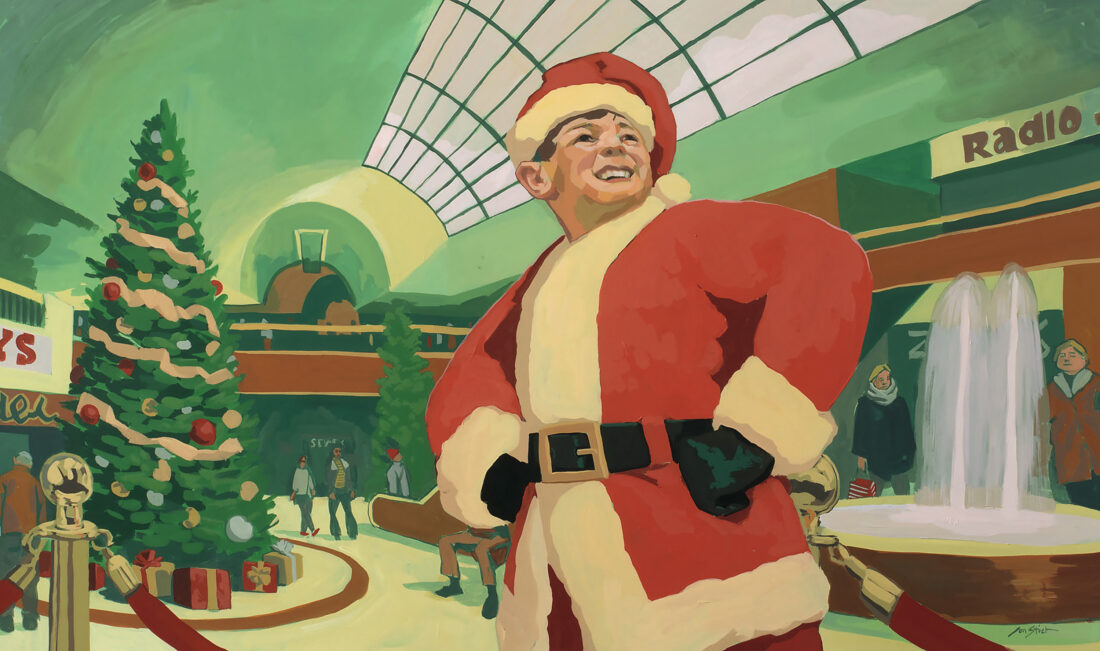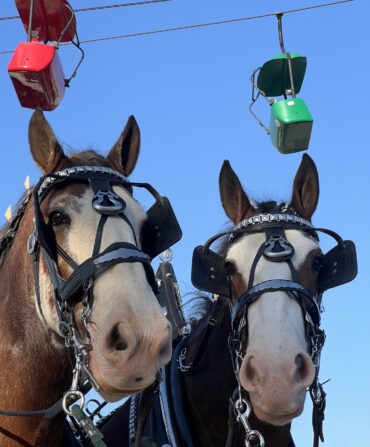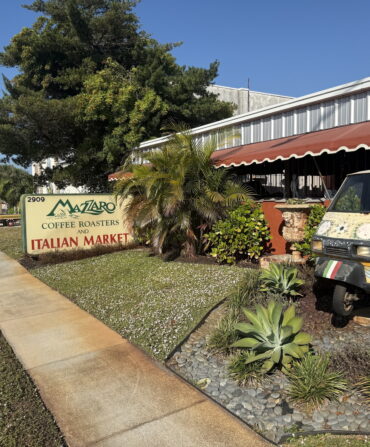Santa Claus didn’t use the chimney that Christmas Eve, and he didn’t wait until we all went to sleep. It was 1973 and St. Nicholas was standing in front of me in my grandmother’s house in Big Stone Gap, Virginia. I was three years old.
Mamaw’s house in Powell Valley—nestled in the Jefferson National Forest, along the Trail of the Lonesome Pine—provided the perfect setting for this life-altering yuletide encounter. When I was growing up, my parents and I would drive there from our home in Winston-Salem, North Carolina, traveling on winding roads through little Virginia towns—Fancy Gap, Chilhowie, Abingdon. Christmas music faded in and out on country radio stations.

As an early gift that year, my aunt Nila mailed me a set of pajamas with a red candy-cane stripe. My mother says I wanted to sleep in those PJs every night. Sometimes when I wore them, I would catch myself in the dining room mirror. Mom remembers I’d sit on a stool, performing.
Once we arrived, our Christmas Eve tradition began. A feast covered the table (ham, sweet potato casserole, deviled eggs, green beans cooked in bacon fat for hours, hot homemade biscuits, pecan pie). Someone would say grace. We read the Christmas story from the Bible. Everybody—sometimes as many as forty guests—exchanged gifts, and then the little kids urged their parents to rush home so they could go to sleep. Santa was coming!
We would get there by 6:30. Many times it was snowing. And so it was on this pivotal Christmas Eve. Sometime between supper and the opening of the presents is when Santa appeared. He was wearing the brightest, most glorious red suit, along with his signature white gloves, patent-leather black belt, and boots, a big red gift bag slung over his shoulder.
As I sat on my father’s knee, I was spellbound.
Santa handed out gifts, but I have no memory of what I got. What was important was that Santa Claus was standing there. Looking at me. Seeing him that night sparked something in my three-year-old self. Suddenly, I had to learn more about this mysterious figure in red.
When I awoke to a frozen Christmas morning, I found a bright red AMF Fire Chief pedal car (complete with a siren and light on the hood), a baker’s hat sewn for me by my mother’s seamstress, and other toys assembled in the living room. I loved everything, but as the day wore on, the gifts felt almost anticlimactic. I was still focused on Santa’s visit the night before.
For the next few months, I could not stop talking about Santa Claus. I would ask my mother to read me “A Visit from St. Nicholas,” Clement C. Moore’s classic poem that most people know as “’Twas the Night before Christmas.” I was transfixed by the imagery of the little old sleigh driver dressed all in fur. The pipe. The round belly. The twinkle in his eye. Hey, I’d seen the same figure! And just as he did in Moore’s poem, Santa had slipped away from Mamaw’s house, into the snowy night.
When we returned to Mamaw’s for our annual summer visit, Mom and I would spend the long afternoons sitting on the yellow metal glider on the front porch. I would make her read Moore’s poem aloud, and then I would try to recite it from memory.
As we got closer to the holidays that year and my mother asked what I wanted for Christmas, I could think of only one answer: “All I want is to see Santa Claus.” My mother then did what she must have thought was the next best thing: If she couldn’t ensure another visit from Santa, then I would become Santa. Mom searched the McCall’s patterns catalogue and found just the one she wanted: Santa Claus Suit (for men).
She again called on her seamstress, Imogene Stevens, who’d made my baker’s hat. She took that pattern “for men” and tailored an elaborate Santa suit for all two and a half feet of me.
On Christmas Eve that year, Mamaw’s church, Powell Valley Presbyterian, staged a play. My cousins had roles as shepherds, the wise men, Joseph, and Mary. We arrived just as the play was ending, but that didn’t stop me from putting on a show. Dressed in my little red suit, I marched down the aisle to the stage and gave an unsolicited performance:
’Twas the night before Christmas,
when all through the house
Not a creature was stirring, not
even a mouse…
As my cousin Rusty Gilly recently recalled, “You got up there and you owned it.”
Back home in North Carolina, I continued giving dramatic performances of Moore’s poem wherever I could—from my kindergarten class to Halloween parties. I scoured family LP collections to find Christmas albums, all year round.
My preoccupation with Old St. Nick culminated when I was six. That year, Mom went to Mrs. Stevens and asked her to help make a white beard for me. While Mom was at home getting ready for Christmas, I got dressed in my full Santa suit and beard. Then I asked Dad to drive me to the newly opened Hanes Mall, then one of the largest indoor malls in the South. He escorted tiny Santa inside, having no idea what I was going to do. I went to the interior entrance to Belk, instructed Dad to stand back—I didn’t want shoppers to know we were connected—and with zero hesitation, I stepped into the Belk Christmas display.
Sometimes I acted as if I were part of an animatronic addition to the holiday mannequins. Shoppers would stop, and I’d watch their faces. Was this real? Had Belk executives, in a new twist on holiday marketing, decided to hire a six-year-old? For two holiday seasons, I went on unpaid tour. To Thalhimers, JCPenney, and Sears.
My family says that my obsession made Christmas real for them. Even then, I could tell how much joy my passion brought everyone. So much so that by the time I’d outgrown the suit and started to develop a sneaking suspicion that there might be something more to this Santa character, I wouldn’t dare say anything or ask questions. I didn’t want to crush my parents.
When I was eleven, the economic woes of that era hit our household. I noticed that the presents on that Christmas morning were modest compared with previous years. I sensed that my parents must have struggled but couldn’t bring myself to even say thank you. That would have meant acknowledging something about Santa Claus that my childhood self would never have accepted. It wasn’t until years later, during an argument with my mom, that she told me how hurt she’d been that year when I didn’t even say thanks. I still couldn’t bring myself to tell her why.
Once when I was in my twenties, I was reminiscing with my parents about Christmases past. “Remember the year that Santa showed up at Mamaw’s?” I said. “Oh, yeah, that was Emory,” Dad blurted out. Uncle Emory, Mom’s brother. It was a jolt to my system. No one had ever spoken of Emory playing Santa.
Rationally, I knew it wasn’t the real Santa I’d met that night. And, yet, that didn’t change what I still see in my mind’s eye about that long-ago Christmas Eve. I was reminded of the old newspaper editorial with the famous line “Yes, Virginia, there is a Santa Claus.” The man in the suit might have been Uncle Emory, but it was Santa that I met. “The most real things in the world are those that neither children nor men can see.”
In 2001, I was living in Washington, D.C., and heard that Uncle Emory was ill. Cancer. Mom was visiting me at the time, so we went to Brooks Brothers to get him a pair of the fanciest pajamas they had and mailed them to him in Big Stone Gap. Emory died one month after 9/11.
On a Zoom call with my cousins last summer, we got to talking about that Christmas Eve when Santa appeared. “I was standing right beside [my brother] Robin when Emory came in,” Rusty said. “Where was I?” asked their sister, Melody. “You were probably on Mom’s lap somewhere,” Rusty said. “I was scared,” Melody said, laughing.
After the Zoom, I called Mom to tell her that this many years later, we were all still thinking about that night. She started crying. “What is it?” I asked. “Emory,” she said. “I wish we had told him how much what he did meant.”








